If you want a 5 volt output then you need to recalculate R1 and R2. At the moment it will regulate to 6.8 volts and not 5 volts. This is because the FB pin needs to "see" 0.8 volts and with 5 volts at the output, it will see 0.588 volts and, as a result, the duty cycle will increase until it sees 0.8 volts and that occurs when Vout = 6.8 volts.
As others have mentioned in comments you need to have the enable input pulled high.
You also need to ensure that the thermal pad beneath your chip is connected to ground and that you have applied enough copper on the PCB to ensure the junction temperature does not exceed 150 degC. Read section 6.4 of the data sheet.
Section 6.5 also draws your attention to correct PCB layout and, at the bottom also reminds you about the thermal pad: -
Thanks to the exposed pad of the device, the ground plane helps to
reduce the thermal resistance junction to ambient; so a large ground
plane, soldered to the exposed pad, enhances the thermal performance
of the converter allowing high power conversion.
